Multilayer PCB refers to a printed circuit board with multiple conductive layers made on a single-layer substrate according to certain design requirements. It achieves high-speed transmission and efficient processing of circuit signals by stacking multiple functional layers together.

Factors affecting the number of layers in multi-layer PCBs
1. Purpose
Where will the circuit board be used?
Circuit boards are used for various types of simple to complex electronic devices. Therefore, it is necessary to determine whether the functionality of the application is minimal or complex.
2. Required signal type
The selection of layers also depends on the type of signal they need to transmit. The signal is divided into high frequency, low frequency, grounded or power supply. For applications that require multiple signal processing, multi-layer circuit boards are required. These circuits may require different grounding and isolation.
3. Type of through-hole
The selection of a through-hole is another important factor to consider.
If a buried through-hole is chosen, more internal layers may be required. Therefore, multi-layer requirements can be met accordingly.
4. Signal layer and pin density
The determination of circuit board layers is also based on two important factors - signal layer and pin density. The number of layers in a circuit board increases as the pin density decreases. The pin density is 1.0. For example, a pin density of 1 would require 2 signal layers. However, pin density<0.2 may require 10 or more layers.
The number of layers on a PCB board affects its performance, manufacturing difficulty, and cost. When selecting the number of PCB layers, we need to comprehensively consider factors such as the complexity, thickness, and cost of the circuit board to achieve optimal performance and manufacturing results.
The main reasons for multi-layer PCB circuit board design
1. Signal integrity
Multilayer circuit board design can improve signal integrity, and reduce signal interference and electromagnetic radiation through electrical connections between layers. Signal integrity is crucial for high-speed transmission of signals, as the waveform and stability of the signal are affected by electromagnetic interference.
2. Space utilization rate
Multilayer circuit board design can fully utilize PCB space, making the circuit board more compact, thereby laying out more devices in the same space, and improving the performance and reliability of the circuit board.
3. Power layering
The multi-layer circuit board design can separate the power supply and ground layer to reduce interference between the power supply and ground. This design can also improve the filtering effect of power supply noise, making the performance of the circuit board more stable.
4. Thermal management
Multilayer circuit board design can achieve better thermal management by adding copper foil between different layers. In high-power devices, this design can better disperse heat, reduce circuit board temperature, and improve device stability and lifespan.
Advantages of multi-layer circuit boards
1. Reduce circuit impedance
The multi-layer circuit board adopts a multi-layer wiring design, which greatly shortens the wire length and thereby reduces the circuit impedance. This design improves the performance of the circuit while reducing signal delay.
2. Improve the efficiency of electric energy transmission
The multiple conductive layers inside a multi-layer circuit board can simultaneously transmit multiple signals, greatly improving the efficiency of power transmission. In addition, multi-layer circuit boards have significant advantages in high-speed digital signal processing due to the insulation material between conductive layers that can reduce electromagnetic interference.
3. Reduce equipment weight
Due to the complex internal structure of multi-layer circuit boards, their thickness is relatively small.
At present, the common layers of PCB boards on the market are single-layer, double-layer, four layers, six layers, eight layers, ten layers, twelve layers, etc. IPCB currently supports up to 108 layers.